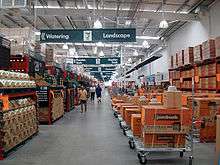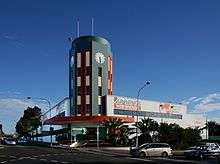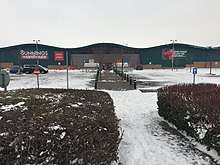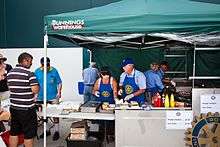Bunnings Warehouse
Bunnings Group, trading as Bunnings Warehouse, is an Australian household hardware chain.[2] The chain has been owned by Wesfarmers since 1994, and has stores in Australia and New Zealand.[3]
 | |
| Subsidiary | |
| Industry | Hardware |
| Founded | 1886 (134 years ago) Perth, Western Australia, Australia |
| Headquarters | Hawthorn East, Victoria, Australia |
Number of locations | 267 (2019)[1] |
Area served | Australia, New Zealand (former: United Kingdom, Ireland) |
Key people | Michael Schneider (CEO/managing director) |
| Revenue | |
| Total assets | |
Number of employees | 31,000+ |
| Parent | Wesfarmers |
| Website | www |
Bunnings was founded in Perth, Western Australia in 1886, by two brothers who had immigrated from England. Initially a limited company focused on sawmilling, it became a public company in 1952 and subsequently expanded into the retail sector, purchasing several hardware stores. Bunnings began to expand into other states in the 1990s, and opened its first warehouse-style store in Melbourne in 1994. The chain currently has 295 stores and over 30,000 employees.[4]
Bunnings has a market share of around 50 percent in the Australian Do-It-Yourself hardware market, with competing chains including Home Timber & Hardware, Mitre 10 and various independent retailers.[5]
Bunnings runs community events outside or in its stores, including sausage sizzles and do it yourself workshops.
History

Pre 1900s
In 1886 brothers Arthur and Robert Bunning left London to settle in Perth, Western Australia, and soon gained a government building contract, which led to them founding a group of building companies which later became Bunning Bros Pty Ltd. They purchased their first sawmill the following year in the south west of Western Australia,[6] and over the next few years they concentrated more on sawmilling and timber distribution and less on building.[7]
20th century
The company expanded to include several new mills around Western Australia. In 1952, Bunnings Limited became a public company, expanded into retailing and purchased several hardware stores.[7] In 1970, Bunnings bought the merchandising and sawmilling operations of the Hawker Siddeley Group. In 1983, they bought out Millars (WA) Pty Ltd and, in 1990, the Alco Handyman hardware operations. The Victorian hardware merchant James McEwan & Co, and two South Australian hardware retailers, Harry's and Lloyds, were acquired by Bunnings in 1993. Many of the stores operated by those companies were subsequently closed, with only the best-performing sites being retained.
Bunnings Limited was bought out by Wesfarmers in 1994. In late 1995, the 'Red Hammer' symbol was introduced, and is still in use today. And in June 1996, the company's trademark slogan "Lowest Prices Are Just The Beginning" was established. However in February 2020, the company removed the iconic slogan from the side of its stores, their website, TV and radio, as well as the staff's green aprons. Bunnings managing director Mike Schneider said the removal of the slogan was to refresh the branding and simplify the message for customers.[8]
Store development post-1994

After the acquisition of Bunnings by Wesfarmers, the first Bunnings Warehouse was opened in the Melbourne suburb of Sunshine by Victorian premier Jeff Kennett and Joe Boros, the managing director of Bunnings. This was quickly followed by three other Melbourne stores. Subsequently, new warehouses have been opened, on average, every three months across Australia. Development in Sydney and Brisbane proved more difficult than in other areas, as large blocks of land in the metropolitan area were limited. In 1997, the remaining smaller-format McEwans stores were renamed "Bunnings".

In August 2001, Wesfarmers bought the Howard Smith Group, owner of BBC Hardware, previously Nock & Kirby, and big-box offshoot, Hardwarehouse. This supplemented the Bunnings national network by several dozen stores, many of them large Hardwarehouse stores in Sydney, Brisbane and New Zealand. Hardwarehouse had been dominant in New South Wales and Queensland, but the purchase complemented Bunnings' prior domination in Victoria, where Hardwarehouse had only seven stores to Bunnings' twenty at the time of the buy-out. The market leader at the time of purchase was Mitre 10 with 12% market share but inclusion of the Hardwarehouse and BBC Hardware stores brought Bunnings market share to 13.5%.[9]
Hardwarehouse and BBC Hardware stores retained their branding for a year, while television advertisements were tagged with each of Bunnings Warehouse, Hardwarehouse and BBC Hardware during this transition period. Lower-volume stores were closed and, in 2002, remaining Hardwarehouses were renamed Bunnings Warehouse.
From 2004 to 2008, Bunnings purchased and re-branded Mitre 10 stores in Griffith, Kempsey, Randwick and Wodonga, Magnet Mart in Griffith and a Mitre 10 Mega store in Modbury. In 2008 the Australian Competition and Consumer Commission (ACCC) looked into its acquisitions of five Mitre 10 stores, as it deemed the purchases would be anti-competitive. In February 2009, the ACCC allowed the purchases, finding that "the acquisition of the Mitre 10 stores did not significantly alter the level of competition in the relevant market."[10]
Since the development of the Bunnings Warehouse stores, two general operational formats exist: Bunnings and Bunnings Warehouse. The smaller "Bunnings" stores stock a more limited range of hardware, whereas the larger "Bunnings Warehouses" contain a more comprehensive hardware range and, often, garden supplies including plants. Over time, some smaller-format Bunnings stores have gradually been closed. However, 2015 saw six new stores open in Victoria, mainly in smaller regional markets and inner-suburban areas. The "big box" format accounts for 167 stores of the network of 280.[11]
COVID-19 pandemic
In mid-May 2020, Bunnings announced that it will close seven stores in Ashburton, Hornby, Hastings, Cambridge, Rangiora, Te Awamutu, and Putaruru with the loss of 145 jobs as a result of the global COVID-19 pandemic.[12][13]
Bunnings Warehouse UK and Ireland

In February 2016, Bunnings' parent company Wesfarmers bought the United Kingdom-based hardware chain Homebase for £340 million. The chain's 265 stores in the UK and 15 in Ireland were intended to be rebranded with the Bunnings name within five years.[14] The first Bunnings store in the UK was opened at the end of January 2017 in St Albans, Hertfordshire, four months later than planned to ensure the adopted format was suited to the UK public. The company planned to use that store as a test model prior to fine-tuning and expanding in that region. In April 2017, they bought a former B&Q store in Folkestone, Kent to be the fifth Bunnings store in the UK.[15]
On 25 May 2018, after mounting losses, Wesfarmers sold the UK and Ireland Bunnings/Homebase operation to the turnaround specialist Hilco for a nominal sum of £1. The 24 stores already rebranded as "Bunnings" reverted to the "Homebase" name, with some later closing under an agreed company voluntary arrangement.[16]
Additional services
Bunnings Warehouse offer a variety of additional services, both in-home and in-store.[17] The in-home services are mainly installations, assembling, quotes and consultancy for multiple products. The in-store services include a hire shop, spare parts enquiry, colour matching, key cutting, pool water testing and gas swapping.
Community involvement

On weekends (and weekdays at some sites), Bunnings outlets regularly host sausage sizzles and cake stalls for community groups and causes.[18] Having become an intrinsic part of the Bunnings Warehouse brand, its sausage sizzles have reached iconic status within the Australian public.[19]
Bunnings also provides gardening, craft, and woodwork do it yourself (DIY) workshops for children in store, as well as for other groups in schools, nursing homes, and hospitals. The Bunnings staff are available to community groups for assistance with DIY projects.
House brands
House brands of Bunnings include:
- Saxon - gardening and landscaping products
- Click - electrical fittings and accessories
- Eiger Electrical - UK and Ireland - electrical supplies
- Ozito - Power tools
See also
- Charles Bunning, played an early role in the development of Bunnings
References
- 2019 Annual Report
- "Officeworks fits in the Bunnings shed". The Australian. 4 April 2007. Retrieved 6 September 2011.
- "Second quarter Retail Sales Results". Wesfarmers Limited. 31 January 2011. Retrieved 31 January 2011.
- "2016 Full-year results – Wesfarmers" (PDF).
- "Hardware giant Bunnings buys Adelaide Tools", The Australian Financial Review, 11 October 2019. Retrieved 10 April 2020.
- "Arthur and Robert Bunning migrated from London to Perth in 1886 and in 1887 they purchased their first sawmill in the south west of Western Australia, marking the formation of Bunning Brothers Limited. They purchased several more sawmills throughout Western Australia.": Battye Library, MN 2701, Bunnings Limited records, ACC 7471A
- "Bunnings History". Bunnings. Retrieved 21 February 2008.
- "Bunnings drops iconic 'lowest prices' slogan". www.9news.com.au. Retrieved 21 July 2020.
- Bunnings BBC marriage could kill off traditional hardware stores
- Bunnings Group – acquisition of five Mitre 10 stores Archived 28 May 2010 at the Wayback Machine Australian Competition and Consumer Commission
- "Costco and Woolies drive big box format". Australian Food News. 28 December 2010.
- Gibson, Anne (12 May 2020). "Bunnings to shut seven NZ stores, 145 staff affected". New Zealand Herald. Archived from the original on 12 May 2020. Retrieved 12 May 2020.
- "Bunnings to close seven NZ stores, with 145 job cuts". Radio New Zealand. 12 May 2020. Archived from the original on 12 May 2020. Retrieved 12 May 2020.
- Neilan, Catherine (29 February 2016). "Homebase to be rebranded Bunnings after Wesfarmers completes £340m acquisition from Home Retail Group – now what's happening with Argos?". City A.M. Retrieved 29 February 2016.
- Chessum, Victoria (25 April 2017). "Bunnings Warehouse chain to replace former B&Q site in Folkestone". kentonline.co.uk. Retrieved 25 April 2017.
- , Purchase Reference .
- "Services". Bunnings Warehouse. Retrieved 28 August 2019.
- "Local Community Support". Bunnings. Retrieved 7 February 2016.
- "49 Thoughts Everyone Has While Shopping at Bunnings". BuzzFeed. Retrieved 7 February 2016.